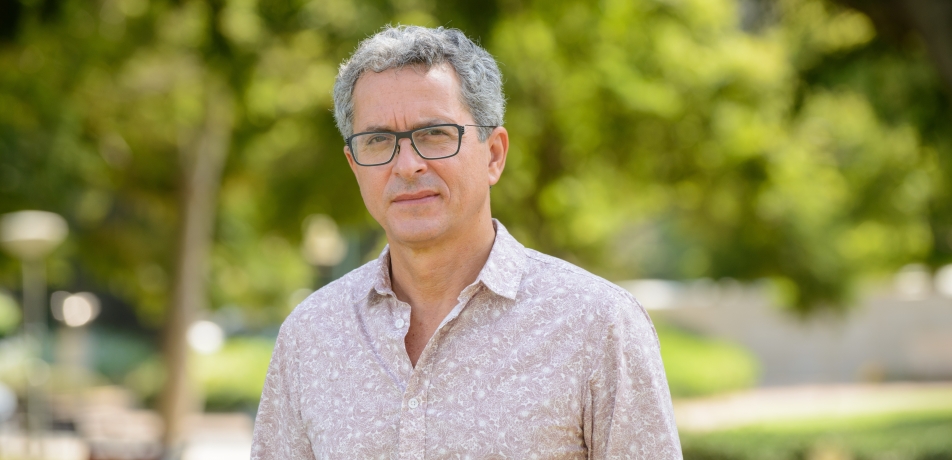Prof. Victor Malka
Bringing laser research to light
New scientists

The tall, white Koffler Accelerator on the Weizmann Institute campus is the icon of Israeli science, and the fact that it is obsolete—because science has come so far, so fast since it was first built in 1976—is, in some ways, an even bigger statement about the prowess of Israeli science.
In planning its construction, Weizmann Institute physicists were seeking a way to accelerate nuclei to study their interactions with one another and their internal organization. Many similar particle accelerators have been built worldwide, the most complex and well-known being CERN in Switzerland, utilized by thousands of physicists.
The newest tenant of that historic facility is, appropriately, a nuclear physicist who has taken particle acceleration to a whole new level: Prof. Victor Malka, a mid-career scientist who, for the last 20 years, has run a world-class laboratory in high-intensity laser physics at the École Polytechnique in Palaiseau, France, and who has directed a leading plasma physics lab at the National Center for Scientific Research (CNRS). He joined the Weizmann Institute in the Department of Physics of Complex Systems in the fall.
Prof. Malka has used laser power to miniaturize particle accelerators into something that fits easily on a lab bench, and even smaller. Conventional particle accelerators require large distances and huge radiofrequency cavities to speed up particles to a velocity that nears the speed of light. Prof. Malka uses powerful but compact lasers focused on a small volume of plasma to accelerate electrons, protons, or highly charged ions, forming them into ultra-bright beams that can be easily controlled.
Plasmas, an ionized medium that contains free electrons and ions, are considered the fourth state of matter after solids, liquids, and gases. Plasmas range from the thermonuclear fires that burn in stars to the cooler plasmas formed within fluorescent light tubes. Physicists have learned to manipulate plasmas to create anything from energy-saving plasma computer screens to superhot, extremely dense plasmas which attempt to reach the threshold of nuclear fusion power.
Since producing the first laser-plasma-driven electron beams in the late 1980s, Prof. Malka has demonstrated new applications in many diverse fields such as medicine, aerospace, and security - for instance, for scanning a truck for hidden explosives - and more. And he hopes to discover more uses for his plasma-powered particle accelerators, making the Weizmann Institute an emerging leader in the field of lasers interacting with plasmas.
Yet he faces a challenge that most new recruits don’t face because they build their labs from scratch upon arriving: transitioning a lab with sophisticated equipment accumulated over 20 years from one country to another. To help in that effort, he recently recruited two PhD students who will spend their first months in his lab in Palaiseau learning to use these challenging instruments.
“These are very powerful, delicate instruments. We have to design and customize them, and then have them installed and calibrated, and train people to use them.” It will take nearly two years from this point to build, ship, and install the lasers that form the heart of the lab.
His new Schwartz/ Reisman Laboratory for Intense Laser Physics is being remodeled in the Koffler Accelerator in the Canada Centre of Nuclear Physics. The foundation of the lab needs to be so stable that passing trucks will not cause any vibrations to disturb the delicate aim of the powerful laser setups.
Beams of promise
The promise of these new laser beams is immense. For instance, his miniature laser-driven particle accelerators can produce streams of protons that can be used for proton and hadron therapies in cancer treatment. These are potential methods for the targeted treatment of tumors located deep in the body, and radiotherapy-resistant cancers. Proton therapy is now widely used for children, whose growing bodies are highly susceptible to collateral damage from radiation therapy; proton therapy is far more precise and therefore avoids destruction of healthy tissue surrounding tumors. However, the conventional proton-generating equipment is both massive and expensive.
In clinically approved prostate treatment experiments, Prof. Malka has already shown that such beams are well-suited for delivering the required dose of radiation, very precisely concentrated, with a deep penetration into tissues, resulting in less damage to adjacent healthy tissue.
He has also demonstrated how his plasma lasers can be used as a powerful portable x-ray for industrial applications that require penetrating dense materials and producing a high-resolution image of features within. Such instruments are being tested for applications in the security field and for inspecting airplane parts for stress and fractures, precluding the need to take them apart.
Prof. Malka believes that his new lab will quickly become a hub of exciting new research avenues, and will work closely with Weizmann Institute specialties such as ultrafast optics, high-energy physics, highresolution microscopy and imaging, and more.
He says he’s thrilled to join the Israeli scientific community, which he admires for its energy, flexibility, and creativity. For the next year and a half, he is dividing his time between his old lab near Paris and his emerging lab here.
“Weizmann has an outstanding scientific environment which motivates me to build my ambitious scientific program here,” says Prof. Malka. He first visited Israel at age 10 and has been a frequent visitor ever since. His parents divide their time between Ashdod and Paris. He is married to Agnes Finquel, an artist, and they have two children (Maya and Dinah) who are looking forward to calling Israel their fulltime home.
Prof. Victor Malka is funded by The Abramson Family Center for Young Scientists, Leona M. and Harry B. Helmsley Charitable Trust, Dr. and Mrs. Irving and Cherna Moskowitz, Sam Revusky, Canada, Gerald Schwartz and Heather Reisman Foundation.